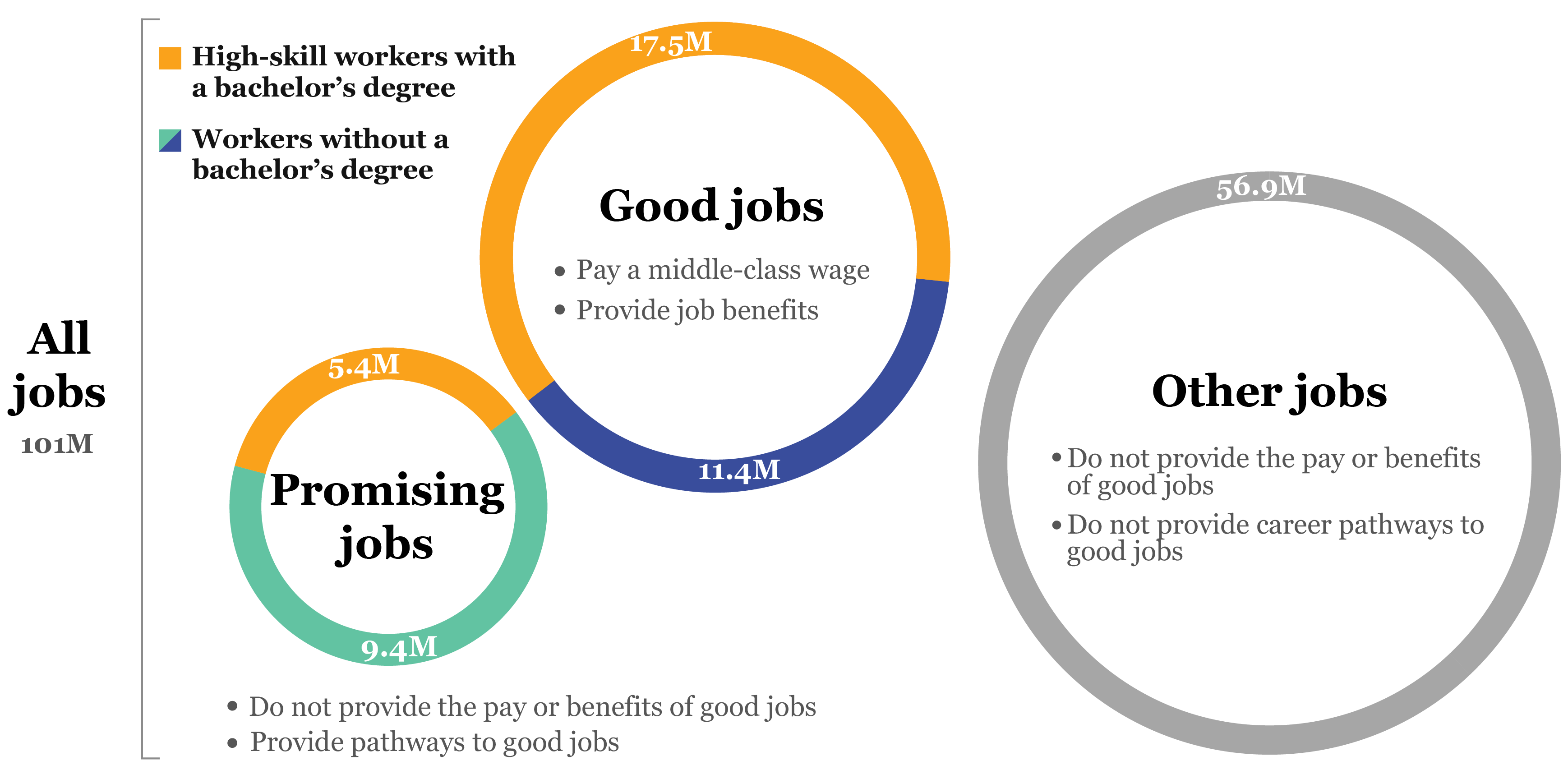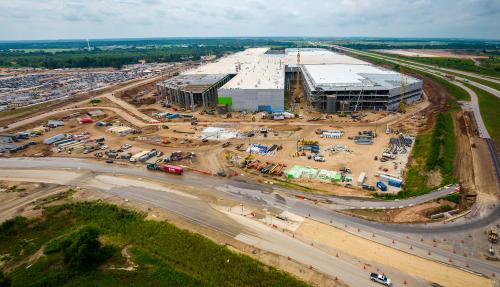In recent decades, technological change and the global integration it enables have been rapidly reshaping the U.S. economy. These forces have improved the potential of some individuals to thrive, but diminished prospects for others striving to reach or maintain their place in the American middle class. Amid these changes, how and where will individuals find durable sources of good jobs?
Certainly, education is an important part of the picture, particularly for enabling upward mobility among young people. But tens of millions of adults who are already a critical part of the American workforce also deserve a chance to obtain better jobs, with higher pay and benefits.
This report shows that the industrial structure and growth of metropolitan economies—in particular, whether they provide sufficient numbers of jobs in opportunity industries—matters greatly for workers’ ability to get ahead economically. It examines the presence of occupations and industries in the nation’s 100 largest metropolitan areas that either currently or over time provide workers access to stable middle-class wages and benefits, particularly for the 38 million prime-age workers without a bachelor’s degree.
Defining good and promising jobs
Our analysis defines three types of wage and salary jobs in each of the nation’s 100 largest metro areas:
- Good jobs provide stable employment, middle-class wages and benefits
- Promising jobs are entry-level positions from which most workers can reach a good job within 10 years
- Other jobs do not provide decent pay, benefits, or pathways to good jobs
We further differentiate these job types by those held by workers who do not possess a four-year bachelor’s degree and those held by high-skill workers who possess at least a four-year bachelor’s degree. This report finds that in 2017, 11.4 million jobs held by workers without a bachelor’s degree in the nation’s 100 largest metro areas were good jobs, while another 9.4 million were promising jobs. But those figures amounted to only one-third of workers without a bachelor’s degree holding good or promising jobs. By contrast, 22.9 million jobs were good or promising for high-skill workers in these metro areas, accounting for 70 percent of all workers with a bachelor’s degree.
Share of good jobs, promising jobs, and other jobs based on the 101 million total jobs in the nation’s 100 largest metropolitan areas

Pathways to good jobs typically involve major career moves to different occupations
Good jobs and promising jobs for workers without a bachelor’s degree tend to concentrate in certain occupations, though not necessarily the same ones. Maintenance, construction, production, and transportation occupations provide disproportionate shares of both good and promising jobs for workers without a bachelor’s degree. Management, business, computer, engineering, and health care occupations are also a significant source of good jobs for these workers. Administrative, sales, food-service, and personal care occupations, on the other hand, provide few good jobs, but many promising jobs that offer stepping stones to better jobs for workers without a bachelor’s degree.
Most promising career pathways to good jobs are “lattices” that run across occupations rather than “ladders” that exist within them. Overall, more than 71 percent of workers projected to obtain a good job by 2027 will move from one major occupation group to another. And more than 90 percent of workers without a bachelor’s degree who start in food service, personal care, facilities care, and health care technician occupations will switch to an entirely different occupational category to obtain a good job.
Read more about job quality and career mobility by occupation on page 8 »
Occupation pathways
…
Many good jobs that promote upward mobility are found in opportunity industries
Because industries organize work around different sets of occupations and skills, they provide varying levels of good and promising jobs. Opportunity industries are those in which good jobs represent an above-average share of the industry’s total jobs.
Tradable industries—those in which firms sell most of their products or services to customers outside the region—contain only about 29 percent of all jobs, but account for 38 percent of good jobs held by workers without a bachelor’s degree. Manufacturing, logistics, and wholesale trade provide especially high concentrations of good jobs, and near-average shares of promising jobs, for these workers. Local-serving industries such as hospitality, retail, and administrative services provide relatively fewer good jobs for workers without a bachelor’s degree, but account for 71 percent of promising jobs held by these workers.
Workers with a bachelor’s degree, on the other hand, tend to find good and promising jobs across a wide range of industries, including tradable industries such as computer systems design, engineering services, and scientific research, and local-serving industries such as health care and education.
Read more about which opportunity industries concentrate good jobs on page 13 »
What are the opportunity industries in each metro area?
…
Note: Not all bars sum to 100%. These are indicated by undefined segments above
Opportunities to obtain a good job depend on metro characteristics
The nation’s 100 largest metro areas vary considerably in the share of their jobs that are good or promising, and in the educational attainment of the workers who hold those jobs. For instance, good or promising jobs held by workers without a bachelor’s degree represent 35 percent of jobs in the Spokane, Wash. metro area, but just 9 percent of jobs in the Washington, D.C. metro area. These differences across metro areas reflect differences in: (a) the educational attainment of local workers; (b) the presence of opportunity industries in local economies; and (c) the company specializations, skill requirements, and pay levels in those local opportunity industries.
Read more about how metropolitan areas contain different concentrations of good jobs on page 16 »
Share of jobs that are good, promising, high skill, or other
…
Strategies to improve opportunity in metropolitan America
Nearly all metropolitan areas do not provide enough good and promising jobs for all the workers who need those opportunities. Yet metro labor markets are dynamic, with many workers switching occupations and industries in order to get ahead. This report identifies three strategies for leaders in cities and regions to enable workers’ mobility to better jobs and the middle class:
- Refocus economic development on opportunity industries. Too often, scarce public resources are spent on incentivizing job growth or retention in industries that provide too little opportunity. Economic development should instead increase the share of good jobs in the local economy. Such jobs not only broaden access to opportunity, but industries that concentrate good jobs also tend to have a greater positive impact on the local economy.
- Partner between government and business to improve job quality. A growing body of research shows that improving job quality—by treating labor as an asset rather than a cost—is good for the bottom line in some sectors that provide many “other” jobs, including retail, hospitality, health care, and education. Improving job quality means not only increasing wages and benefits, but also improving the visibility of pathways from low-quality jobs to better ones.
- Retool education and workforce development for a dynamic labor market. The constant emergence of new technologies means workers may need to switch careers more often to access opportunity. Specific knowledge and skills remain essential to getting a job, but keeping that job or finding a better one may require workers and institutions to focus more on developing abstract cognitive abilities that enable people to think and learn by themselves, and to adapt to continuous change in the labor market.
Read about strategies local leaders can take to develop more good jobs on page 21 »
Interactive by Alec Friedhoff
Related Content

Chad Shearer, Isha Shah, Mark Muro
December 17, 2018

Chad Shearer, Isha Shah, Alec Friedhoff, Alan Berube
February 20, 2018
Authors





